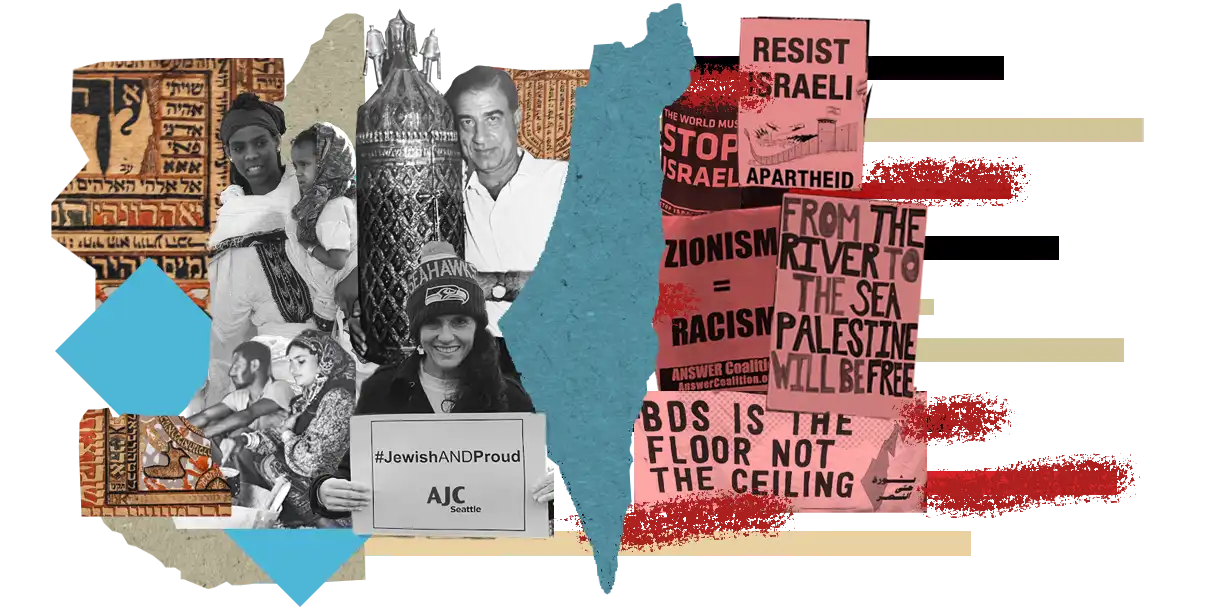In my role as regional director of American Jewish Committee (AJC) Seattle, I advocate on areas of concern to the Jewish community. Increasingly, this involves attempting to educate public officials who support antisemitic policies in opposition to Israel — often without them even understanding the connection between anti-Zionism and antisemitism. My mere physical presence within those conversations has a way of razing some preset Jewish stereotypes, changing the direction of several of those exchanges — at least initially.
I have been told countless times that I “don’t look Jewish,” a comment that can be interpreted several ways, none of which are a positive reflection of Jews. Having olive skin, dark hair and other features I inherited from my Mizrahi side of the family often provides an advantage when countering false messaging that the modern State of Israel is inhabited by European “white” Jews who feign ancestral ties in the Middle East as their justification to “steal” Palestinian land.
I recall one conversation I had with a local elected official who had taken a leading role in the “Block the Boat” campaign that attempted to intercept a cargo ship from unloading at the Port of Seattle because it was owned by a publicly traded Israeli company. During a private off-the-record conversaation between us and a few others, the elected official shared her family history as the daughter of one parent from a multi-generational American and another who emigrated from Mexico. She inferred that this background gave her a unique perspective into the relationship between those who possess power and those who are oppressed.
Her story opened a window for me to do the same. I shared a parallel background of being a Jewish American whose maternal great-grandmother was born in America, yet whose father fled persecution in Iraq to find refuge elsewhere.
At that point in the meeting, I began receiving messages from the elected official’s staff member to schedule a one-on-one, face-to-face meeting with the elected official as soon as possible. The tone of the meeting quickly went from guarded, cold and slightly defensive to warm, comfortable and open.
While my looks and family story can result in being accepted initially as someone relatable and therefore a potential ally, those who strategically engage in anti-Israel behavior eventually prevail by casting me as a supreme threat. ”
In these types of situations, the civility between us may persist but the collegiality unfortunately tends to be short-lived. While my looks and family story can result in being accepted initially as someone relatable and therefore a potential ally, those who strategically engage in anti-Israel behavior eventually prevail by casting me as a supreme threat — a person who by her very existence flies in the face of their prescribed narrative of what defines a Jew. Ultimately, some don’t want to have anything to do with me because they don’t want their fictitious narrative challenged.
The social acceptance of the falsehoods that fuel antisemitism from anti-Israel rhetoric and violence continue to grow and remain largely unrecognized. Though forms of Jew-hatred might manifest differently, a consistent foundational hallmark is the perception of Jewish power.
In May 2021, after Hamas, the Palestinian Islamist organization that currently controls Gaza, barraged Israel with thousands of rockets, Israel struck back. This seemed to give validity to countless antisemites to use the conflict as a pretext to attack Jews wherever they could be found. Statistics showed a 141% increase that month alone in antisemitic incidents in the U.S., with 40% of them including references to Israel or Zionism.
Denying these acts of overt Jew-hatred, validating them as legitimate protest or simply animus to Israel’s existence, fosters the problem. The connection between Israel and the Jewish people cannot be denied. Judaism and Zionism are intrinsically linked, as are anti-Zionism and antisemitism. When Jews are targeted and attacked and our institutions defaced and vandalized in opposition to actions of the Israeli government or simply from the country’s existence, that’s antisemitism. The ideology of anti-Zionism offers no compromises on borders and boundaries, a two-state solution or any other. It is unequivocal in its objective — the destruction of the State of Israel, the world’s only Jewish state.
History shows the Jewish people are indigenous to the Middle East, having been a nation for over 3,000 years, originating in the biblical Land of Israel, where an uninterrupted presence has been maintained. The complexity and understanding of who and what Jews are remains a challenge. Jews are a diversity of nationalities, ethnicities, heritages and cultures — and what many don’t know is that after King Nebuchadnezzar forced their exile from Judea around 586 BCE, the Jews were brought to ancient Babylonia, modern-day Iraq. Many did not migrate far, settling in nearby lands. In addition to Iraq, they lived in what are now Morocco, Algeria, Tunisia, Libya, Yemen, Syria, Lebanon, Egypt, and Iran. Nearly a million Jews were ethnically cleansed from those countries in the last century.
The reality of Mizrahi Jews is a tough fact for the anti-Israel camp to swallow and is often accompanied with much resistance as it shatters the myth of Jews as white colonizers. Holding onto the falsehoods effectively erases the diversity of backgrounds and cultures within the Jewish people. This even carries over to different Arab nations accusing Jews of culturally appropriating traditional Middle Eastern and North African dishes, an absurd attempt to wipe out any trace linking Jews to those lands.
The Jewish community in Iraq was the oldest continuous diaspora community at more than 2,600 years. When Judea was recaptured by the Persians, the Jews were allowed to return. It’s said that around 80,000 Jews remained in Babylonia, and I am a descendent of this group. When Islam was established in the seventh century, the Jewish community became subsumed under the Muslim caliphate. Jews, as non-Muslims, were granted some protections by the Islamic state, but had to pay a special tax, carry themselves with the lower-class Dhimmi status and be subjected to other established means of systemic discrimination.
Over the two-day Shavuot holiday in June 1941, the Jewish community in Baghdad was terrorized during a pogrom known as the Farhud (translated as “violent dispossession”). Hundreds of Jews were murdered, raped and tortured, and Jewish homes and businesses were vandalized. At the time, Iraq’s Jewish population totaled about 150,000 and about one-third of Baghdad’s residents were said to be Jewish. The vast majority of the Jewish community in Iraq, including my father’s family, ultimately found refuge in Israel through the Operation Ezra and Nehemiah airlifts in 1951 and 1952. A Jewish community that existed in Iraq for more than 2,600 years has dwindled today to no more than four people, according to various reports.
In spite of this history, many progressive circles in the U.S. have shifted Jews into the category of “white,” completely ignoring the fact that Jews in America have been among the groups regularly subjected to discriminatory acts like neighborhood redlining, club exclusions, university admissions and employment bias. In the structure of “social justice,” Jews not only are expected to self-identify as white but recognize themselves as a privileged class that holds power. Those who are perceived to have power are always the oppressor and the “powerless” are always the oppressed. Jews in progressive spaces are expected to relinquish any affinity for Israel and identification as Zionists. The term “Progressive Except for Palestine (PEP)” has become a litmus test of exclusion from many progressive circles. If American Jews don’t denounce their support of Israel, they are considered complicit in Palestinian oppression.
On June 23, 2014, Israel’s Knesset adopted a law that designates November 30 as a day to recognize the expulsion of nearly a million Jews from Arab lands. The largely ignored story of these Jewish refugees, their persecution, displacement and resulting trauma is an integral part of Jewish history and is vital to recognize. My family history, like that of many other Mizrahi Jews, belies this pigeonholing of Jews as white, always among the powerful and never among the oppressed.



